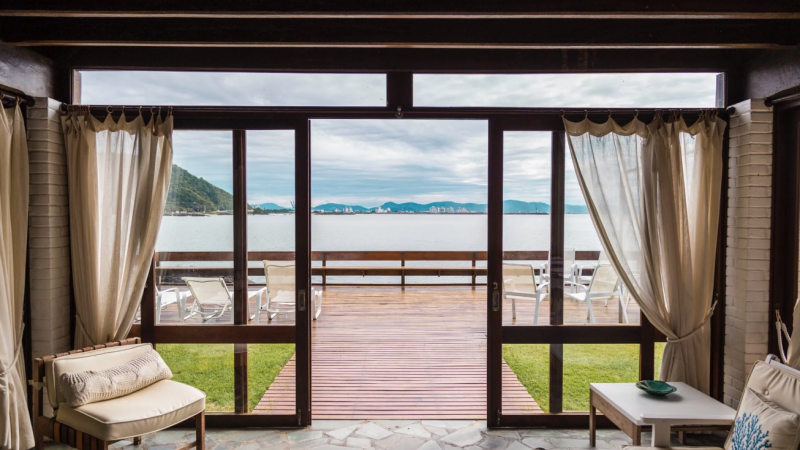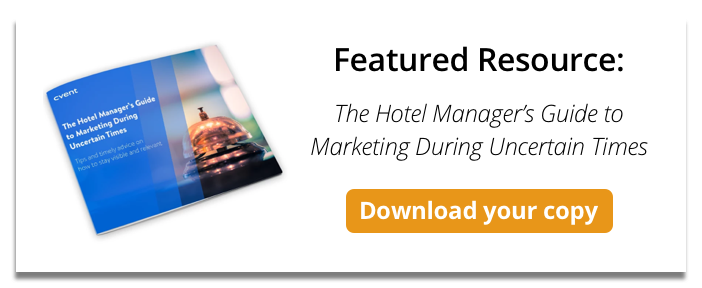Direct bookings have gained on OTAs in recent years, and they’re more profitable for hotels—in both lower costs and higher average daily rates (ADR). One of the most effective strategies for driving prospective guests to your website is affiliate marketing. And though launching a program requires some heavy-lifting, it's well worth the effort. Once established, this marketing strategy is relatively hands-off.
Read on to learn about hotel affiliate marketing and the must-know steps to create a successful affiliate program or improve the ROI of your existing one.
How do hotel affiliate marketing programs work?
Through affiliate marketing, people known as ‘affiliates’ encourage others to book stays or meetings at your hotel in exchange for a commission. Affiliates are often blog authors, niche travel experts, or social media influencers with a robust and engaged following on platforms like Instagram and YouTube.
Find out how to market to thousands of event planners
With pre-established networks, affiliates give you access to a broad potential customer base with a high degree of trust in their opinions. By the time their audience members visit your website, they are further along the sales funnel and more likely to take action, whether it’s subscribing to your hotel newsletter, reserving a room, or booking a meeting space.
Take it step-by-step, and you’ll build an affiliate program that gets results.
Step 1. Set crystal-clear goals for your affiliate marketing program
One of the greatest benefits of affiliate marketing is its flexibility—you can engage affiliates for broad or targeted goals. You can also engage them across your portfolio or for individual properties. The key is to set clear goals, all tied to increasing revenue. Some goals to consider:
Build your brand.
Is your target customer value-driven, or focused on luxury? Family or independent traveler? Business or pleasure? Choose affiliate marketers with a similar audience to showcase your accommodations and amenities that appeal to those customers.
Compete locally.
You and your competitors probably come up in online searches for hotels. The audience of your affiliates will be more familiar with your hotel and seek out your website or click on an ad or link that takes them to your website for bookings.
Improve occupancy rates.
Publishers in your network should add regular links that lead directly to your reservation platform, which can dramatically increase bookings and occupancy rates. Affiliates help you stay in front of your target audience repeatedly—a crucial strategy considering online travel booking abandonment rates sit at 90 percent.
Build booking consistency.
In addition to excellent hotel customer service, a positive first impression from a trusted source drives guest loyalty. Affiliates become a trusted source for their audience, and you earn more consistent bookings across seasons. Additionally, as you build long-term partnerships, you can identify patterns and forecast how many bookings the publisher garners.
Extend market reach.
Affiliate marketing offers opportunities for more direct sales. Capturing the attention of even a small percentage of a blogger’s 1,000,000 monthly visitors can make a dramatic impact on sales, as can tapping a large percentage of the smaller audience of a blogger who speaks to your hotel’s niche.
Step 2. Analyze the competition’s affiliate programs
To build a strong affiliate program, it’s helpful to identify what your competitors are doing well and look for opportunities to differentiate your program. Areas to focus on during this competitive analysis include:
- Affiliates. Who are the publishers (bloggers, social media influencers) they are using? Are they active? Are they positively representing the hotel property?
- In-house/network program. Is your competitor running their affiliate marketing program in-house or are they using a professional affiliate networking service?
- Sub-affiliate reach. Are competitor affiliates actively incentivizing readers or followers to promote their brand, and can those incentives be replicated by your publishers?
- Content and niche. What type of strategic messaging is your competitor putting out via their affiliate marketers? Are their affiliates focused on driving business travelers or families?
- Commission, payments, and cookie length. How are they compensating their affiliates? (This information should be readily available on your competitor’s affiliate marketing website page.)
- Promotions (via text/ad links). What are the special discounts and offers your competitor is focusing on within their affiliate marketing?
- Terms. What are they allowing/not allowing their publishers to do, and how can you differentiate your offerings to attract quality affiliates?
Step 3. Decide your affiliate marketing payment structure
Beyond the initial set-up costs, you have to pay your key influencers and choose a payment structure. The range is pretty wide-open, with the average affiliate commission rate between 5 and 30 percent of generated revenue, depending on the cost of rooms and other factors. Here are the most common payment structures:
- Pay-per-click. The affiliate redirects guests from their blog, website, or social media account to your hotel website and you pay them based on clicks. This is known as earnings per click (EPC) and has a common formula of commission per 100 clicks (e.g, $20 for 100 clicks).
- Pay-per-lead. In this structure, you only pay the affiliate when people who visit your website on their recommendation complete a desired action, such as filling out a contact form, subscribing to a newsletter, or requesting more information.
- Pay-per-booking. This is when you pay your affiliate a percentage of the sale price of the room bookings. This can be nuanced to further incentivize your affiliates, with a higher payout percentage (5 percent) when customers prepay and lower (4 percent) when they pay at check-out.
- Payout. You determine when an affiliate is paid. For example, you can decide this happens on the first of the month after they hit a certain threshold (say $25).
Step 4. Choose the right affiliate marketers for your hotel
Today’s affiliate marketers are generally bloggers and social media personalities, with followings on Twitter, Instagram, and YouTube. In many cases, they’ll post their work to multiple platforms. Instagram, in particular, is a hub of activity for creative influencers turning their joy of travel into fame.
Before exploring affiliates, research how your guests find hotels and who they look to for advice and information. Uncover this information through post-visit surveys and even conversations at the front desk. Hint: Younger guests will likely turn to social media, while older guests may enjoy a long read on a blog or in a magazine.
When partnering with affiliates, selectivity is essential. You don’t want to approve every influencer or blogger who applies to your program. Here are the most essential qualities and data points to look for:
Transparency.
Because trust improves engagement rates and conversions, make sure your bloggers and influencers are upfront that they’re affiliate marketers. For example, popular travel blogger Nomadic Matt shares a prominent disclosure statement on his ‘Travel Resources’ page. It reads: “Please note that some of the links below are affiliate links, including the HostGator link, and, at no additional cost to you, I may earn a commission if you make a purchase.”
Followers, reach, and engagement.
You want influencers with high follower counts and bloggers with high page views. Affiliates should show up high in search results for key terms, such as ‘business hotel advice’ or ‘best mid-range hotels for families in Ohio.
Of course, you want real engagement and followers who are actual people and not bots. A few things to watch for to ensure your influencers have real-world influence:
- Consistent postings. Sudden activity followed by low activity is a red flag that the influencer doesn’t have true clout.
- Originality. This is a crowded space with lots of pictures of beautiful hotel rooms and stunning views. Explore feeds closely, looking for differentiators, such as creativity, playfulness, or business-travel savvy.
- Follower/following ratio. Look for influencers who are following a low number of people and have a high follower count.
- Likes and shares. You want significant likes and retweets, with some fluctuation, but no major dips and drop-offs. Here too, a flurry of activity followed by inactivity is a warning sign.
- Engaged comments. Review comments over time. Signs of an engaged audience include thoughtful comments beyond ‘Beautiful!’ and ‘Wow!’ and responses to comments within the follower community.
- Strong, relevant content. An Instagram travel influencer or blogger with a massive following may attract followers more interested in travel style and food than discovering places to stay. Chances are there won’t be much traction there. Instead, look for affiliates who include hotels in their coverage.
Perhaps you want to target a particular group, such as female travelers flying solo. For example, Kiersten “Kiki” Rich, otherwise known as The Blonde Abroad, reaches this audience with one million monthly page views. A partnership with her could help grow this niche guest base.
Backlinks.
Blogs with backlinks (links from outside websites) demonstrate the affiliate is growing their organic website traffic and building credibility with readers—which bodes well for driving those readers to your hotel website. You can use tools like Ahrefs to see all the websites linking to a particular blogger.
Professional associations.
Groups like the North American Travel Journalists Association and the Society of American Travel Writers (SATW) offer resources for connecting with potential affiliate marketers. The Professional Travel Bloggers Association makes it easy with a section designed for hotels and other travel industry businesses looking for bloggers.
In-person authenticity.
There are several major travel media events where you can meet bloggers and influencers face-to-face to find the right match. Events to check out include TBEX, TravelCon, the SATW annual convention, and Travel Media Showcase.
Step 5. Market your affiliate program to key influencers
Finding the right influencer is just the beginning; you then have to convince them to join your affiliate marketing program. Start by understanding what matters most to your target influencers. This may be:
- Income. This is a career for most influencers, so assume they are looking for substantial income from their affiliate partners. They are also a savvy group. Some influencers will only partner with luxe properties because of the larger commissions, while others will gravitate towards budget properties where commissions are lower but volume is often higher.
- Brand affiliation. A blogger or social media influencer looking to find their niche in the travel industry needs to have a resume full of industry-related partners. Having your hotel in their portfolio boosts their cachet and attracts even more readers and followers
- Followings. This must be a mutually beneficial relationship. The influencer helps increase visitors to your website AND they earn higher follower numbers through association, activity, and proven value.
- Perks. Discounts on services such as spa treatments, free meals, swag, and even a free night or two at your hotel can be part of the package. However, this shouldn’t be a reward for posting positive reviews of these services—that is a no-no that lowers trust levels fast.
- Locations for photoshoots. Many influencers, especially those on Instagram, use high-quality photography and interactive video Stories as an important part of their online presence. Leverage access to your indoor and outdoor facilities, as well as your proximity to natural wonders and unique architecture as selling points.
Once you know what your ideal influencer wants, clarify exactly how they’ll benefit from participation on your affiliate program website and through ongoing social media posts.
Step 6. Decide between in-house and affiliate networks
You can establish an affiliate program directly through your website, which requires an affiliate manager and staff (depending on the scope of your program). Alternatively, you can engage with a third-party network, such as Commission Junction, which is essentially an affiliate program service provider. Each approach has its pros and cons, which you’ll have to weigh based on your goals and your budget.
In-house hotel affiliate programs
Pros:
Direct control over who you choose as publishers, as well as content and branding.
Higher affiliate rates because you won’t have to pay network fees. This helps you access better-quality affiliates.
Cons:
Longer turnaround time for results because you are building your program from scratch.
Higher overhead. In-house programs require employees who vet affiliates, oversee content, and ensure payments. And these employees require salaries and benefits.
Network hotel affiliate programs
Pros:
Established programs. Look for reviews from existing customers and data proving results.
Turnkey startup. The best programs help you launch an affiliate program seamlessly.
Access to a wide array of properly vetted publishers.
Customer support, expertise, and faster results.
Cons:
Recurring fees.
Service overlap with competitors.
Step 7. Set up your hotel's affiliate marketing program specifics
As we mentioned, affiliate programs are fairly low-maintenance once they are up and running. But you need to have the right tools to get the program going.
Software.
You will need the right technology platform for your hotel program tying-in analytics to commissions. Many eCommerce platforms have affiliate functionality, and if not, there are plugins or third-party network providers.
Terms.
Make sure you have your affiliates sign-off on what they need and are allowed to do/not allowed to do when promoting your hotel. Some common terms include:
Hosting a live website that’s fully operational.
Having a privacy policy published on the website.
Using hotel services or brand specifically for the affiliate marketing agreement and not for any unrelated commercial purposes.
Not making any false or fraudulent statements about the hotel.
Being sure the website does not feature offensive content.
Not altering any hotel creative materials without permission.
Payments.
Determine how much you are offering to pay affiliates (commission), what you are paying them for (clicks, conversions, bookings), and when the payout takes place (monthly/threshold).
Cookie length.
Cookies track visitors coming to your hotel website from an affiliate; the cookie length is how long the affiliate is eligible for a commission on that visitor’s action. Cookie length in the hotel industry averages 30 days.
Promotional materials.
Your affiliates need to have content, links, banner ads, images, and other material to use in their blogging and social media activity. You can provide these via a secure, password-protected section of your website or send in a .zip file via email.
Step 8. Track your ROI to refine your affiliate program over time
Key performance indicators to track to ensure your affiliate marketing program is worth the effort and cost:
Click-through rate.
This is a great way to see which links, ads, and creative content on affiliate blogs or social media accounts are working and which are not. The term refers to the regularity an asset is clicked-on by a user, calculated by clicks divided by the number of times the ad is shown.
Cost-per-click.
How much are you paying for website traffic? This measures your cost per sale, click, or lead, calculated as total cost divided by total numbers of sales/clicks/leads.
Conversion rate.
Calculated as the number of sales divided by the number of clicks, this can help shed light on which creative content, offers, and affiliates are most effective. A good rule of thumb is to shoot for at least 10 percent of affiliate traffic resulting in actual bookings.
Incremental sales.
Speaking of actual bookings...keep an eye on how many are being driven by your affiliates that you would not be seeing via other marketing activity. This revenue will determine the overall effectiveness of your affiliate marketing, and help you decide whether to pour more resources into the program or scale-back.
Start building your hotel affiliate marketing program today.
Whether you build an affiliate program in-house or use a third-party service, let this guide help you target your goals, track your success, and make adjustments where needed.
Ready for more tips that drive bookings and increase revenue? Check out our free Ultimate Guide to Digital Marketing for more insights and best practices.







